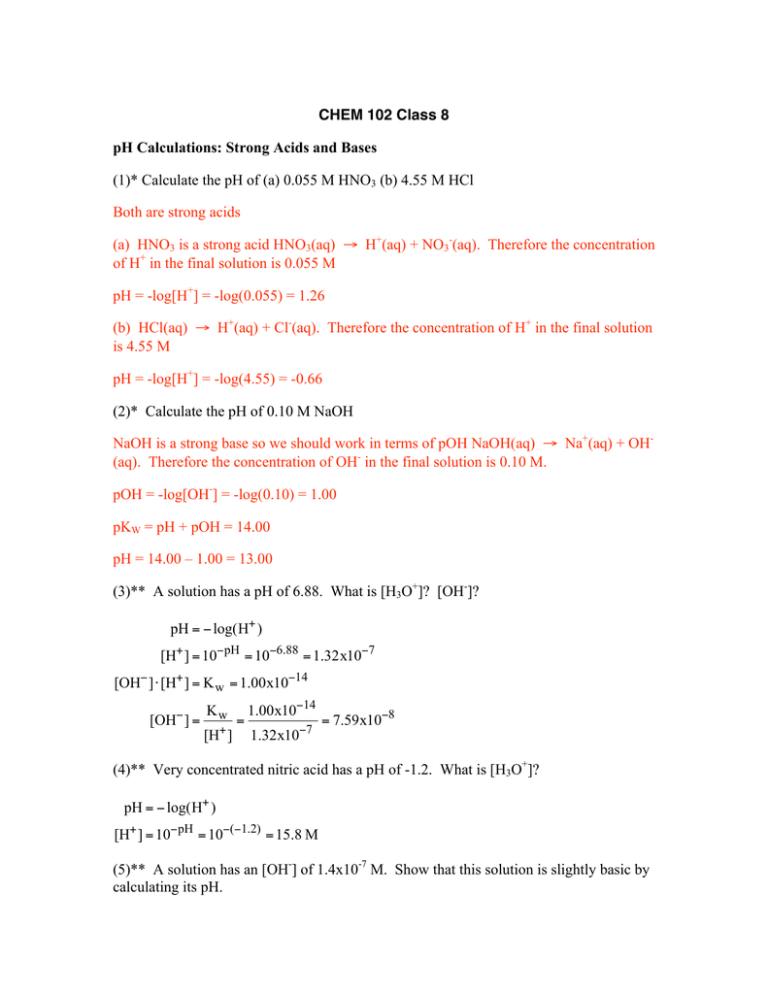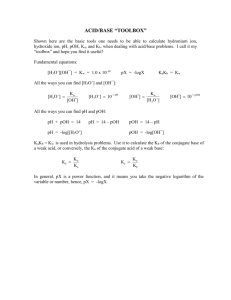CHEM 102 Class 8 pH Calculations: Strong Acids and Bases (1
advertisement

CHEM 102 Class 8 pH Calculations: Strong Acids and Bases (1)* Calculate the pH of (a) 0.055 M HNO3 (b) 4.55 M HCl Both are strong acids (a) HNO3 is a strong acid HNO3(aq) → H+(aq) + NO3-(aq). Therefore the concentration of H+ in the final solution is 0.055 M pH = -log[H+] = -log(0.055) = 1.26 (b) HCl(aq) → H+(aq) + Cl-(aq). Therefore the concentration of H+ in the final solution is 4.55 M pH = -log[H+] = -log(4.55) = -0.66 (2)* Calculate the pH of 0.10 M NaOH NaOH is a strong base so we should work in terms of pOH NaOH(aq) → Na+(aq) + OH(aq). Therefore the concentration of OH- in the final solution is 0.10 M. pOH = -log[OH-] = -log(0.10) = 1.00 pKW = pH + pOH = 14.00 pH = 14.00 – 1.00 = 13.00 (3)** A solution has a pH of 6.88. What is [H3O+]? [OH-]? pH = − log(H+ ) [H+ ] = 10−pH = 10−6.88 = 1.32x10−7 [OH− ]⋅ [H+ ] = K w = 1.00x10−14 [OH− ] = Kw + [H ] = 1.00x10−14 −7 1.32x10 = 7.59x10−8 (4)** Very concentrated nitric acid has a pH of -1.2. What is [H3O+]? € pH = − log(H+ ) [H+ ] = 10−pH = 10−(−1.2) = 15.8 M (5)** A solution has an [OH-] of 1.4x10-7 M. Show that this solution is slightly basic by calculating its pH. € pOH = − log(OH− ) = − log(1.4x10−7 ) = 6.85 pK w = pH + pOH = 14.0 pH = 14.0 − pOH = 7.15 € Since the pH is greater than 7.00 (neutral) the concentration of hydroxide exceeds hydronium and the solution is basic (6)** Like any equilibrium constant, Kw varies with temperature. Its value at 37 °C is 2.4x10-14. What is the pH of (neutral) pure water at 37 °C? K w = [H3O+ ]⋅ [OH− ] = 2.4x10−14 [H3O+ ]⋅ [H3O+ ] = 2.4x10−14 [H3O+ ] = 2.4x10−14 = 1.55x10−7 pH = − log(1.55x10−7 ) = 6.81 (7)** A solution has a [H+] of 6.7x10-4 M. What are [OH-] and pOH? € pH = − log(H+ ) = − log(6.7x10−4 ) = 3.17 pOH = pK w − pH = 14.00 − 3.17 = 10.83 [OH− ] = 10−pOH = 10−10.83 = 1.48x10−11 pH Calculations: Weak Acids and Bases € (8)** Calculate (a) the pH and (b) percent ionization of 1.0 M acetic acid if the Ka is 1.86x10-5 at 20 °C. (a) This is a weak acid CH3CO2H _ CH3CO2- + H+. Writing an expression for Ka gives − [H+ ]⋅ [CH3CO2 ] Ka = = 1.86x10−5 [CH3CO2H] € We’ll assume that H3O+ comes only from the acetic acid (not from water) and that the dissociation is small so the concentration of the acetic acid is unchanged, both reasonable given the size of Ka. −5 1.86x10 [H+ ]⋅ [CH3CO2 ] [H+ ]⋅ [H+ ] [H+ ]2 = = = [CH3CO2H] [CH3CO2H] 1.0 − [H+ ]2 = 1.86x10−5 ×1.0 [H+ ] = 1.86x10−5 = 4.31x10−3 € Checking the assumptions: H+ from water (10-7 M / 4.31x10-3 M) x 100 = 0.0023% Initial [CH3CO2H] unchanged (4.31x10-3 M / 1.0 M) x 100 = 0.43 % The last step is to calculate pH pH = − log(H+ ) = − log(4.31x10−3 ) = 2.37 (b) The percent ionization is defined as € % ionization = [H + ]eqm [HA]initial 4.31x10−3 M × 100 = × 100 = 0.43% 1.0 M (9)** Calculate the pH of 0.004 M solution of vitamin C (ascorbic acid, Ka is 1.0x10-5 at 20 °C). This is a weak acid AscH _ Asc- + H+. Writing an expression for Ka gives Ka = € [H+ ]⋅ [Asc− ] = 1.0x10−5 [AscH] We’ll assume that H3O+ comes only from the ascorbic acid (not from water) and that the dissociation is small so the concentration of the acetic acid is unchanged, both reasonable given the size of Ka. −5 1.0x10 [H+ ]⋅ [Asc− ] [H+ ]⋅ [H+ ] [H+ ]2 = = = [AscH] [AscH] 0.004 [H+ ]2 = 1.0x10−5 × 0.004 [H+ ] = 4.0x10−8 = 2.0x10−4 Checking the assumptions: € H+ from water (10-7 M / 2.0x10-4 M) x 100 = 0.05% Initial [AscH] unchanged (2.0x10-4 M / 0.004 M) x 100 = 5.0 % Note that this is the limit of the error we can tolerate in the second case. If the concentration was any smaller, we’d have to solve a quadratic. The last step is to calculate pH pH = − log(H+ ) = − log(2.0x10−4 ) = 3.7 € (10)*** Calculate the [H+] of 0.20 M phosphoric acid (H3PO4) if the Ka1 is 7.2x10-3, Ka2 = 6.3x10-8, Ka3 = 4.2x10-13 at 25 °C. This is a weak polyprotic acid that only the first ionization, Ka1, effectively contributes to the [H+] H3PO4 _ H2PO4- + H+. Writing an expression for Ka gives − [H+ ]⋅ [H2PO4 ] Ka 1 = = 7.2x10−3 [H3PO4 ] € We’ll assume that H3O+ comes only from the phosphoric acid (not from water) and that the dissociation is small so the concentration of the phosphoric acid is unchanged, both reasonable given the size of Ka. −3 7.2x10 [H+ ]⋅ [H2PO4 ] [H+ ]⋅ [H+ ] [H+ ]2 = = = [H3PO 4 ] [H3PO4 ] 0.2 − [H+ ]2 = 7.2x10−3 × 0.2 [H+ ] = 1.44x10−3 = 3.79x10−2 Checking the assumptions: € H+ from water (10-7 M / 3.79x10-2 M) x 100 = 0.00026% Initial [H3PO4] unchanged (3.79x10-2 M / 0.2 M) x 100 = 18.95 % The last step shows that the second assumption is not valid. Hence we must rewrite the equation for Ka1 as −3 7.2x10 [H+ ]⋅ [H2PO 4 ] [H+ ]⋅ [H+ ] [H+ ]2 = = = [H3PO4 ] [H3PO4 ]init − [H+ ] 0.2 − [H+ ] − 7.2x10−30.2 − [H+ ] = [H+ ]2 0.00144 − 7.2x10−3[H+ ] = [H+ ]2 0 = [H+ ]2 + 7.2x10−3[H+ ] − 0.00144 This is a quadratic equation with solutions 0.0345 and -0.0417. Clearly the negative root is inappropriate. € Note the difference in [H+] is significant at ((0.0379 – 0.0345) / 0.0345) x 100 = 9.9%





